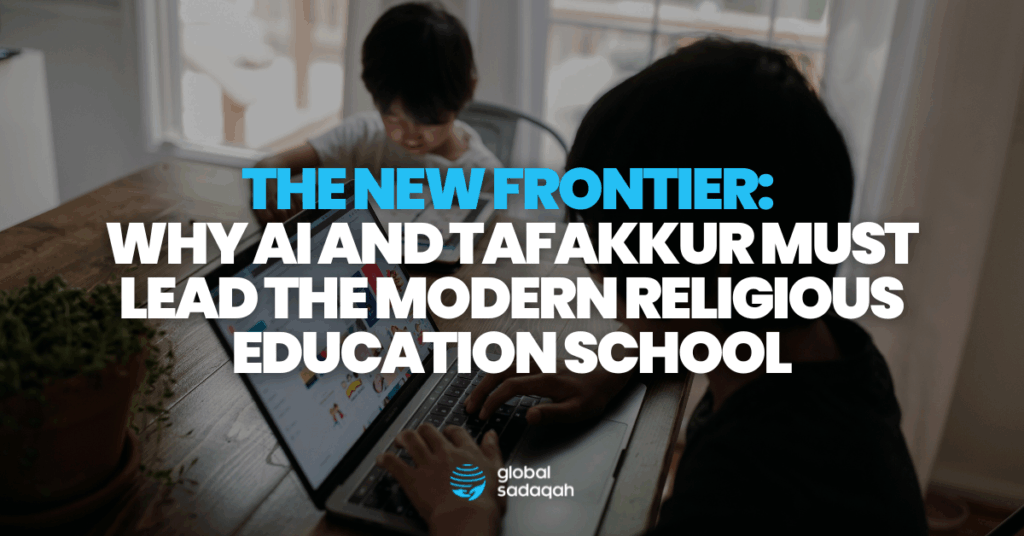The essence of Islamic learning has always been the pursuit of ‘Ilm (knowledge) and Hikmah (wisdom). Yet, for too long, religious studies have been trapped in a cycle of rote memorization. Today, in the age of Artificial Intelligence (AI) and instant information, the traditional approach is simply failing to equip our students—the future leaders—with the tools to navigate a complex world.
The challenge for every Religious Education School is clear: we must move beyond merely learning facts and foster Tafakkur (critical reflection, contemplation) as the core skill, leveraging AI as our newest instrument.
1. The Crisis of Rote Learning and the Call for Tafakkur
Memorizing the Qur’an and Hadith is a blessed and foundational act, but knowledge that doesn’t lead to understanding (Fahm) and action (‘Amal) risks being shallow. The Qur’an itself repeatedly urges believers to observe, reflect, and contemplate the creation, which is the very definition of Tafakkur.
The problem with the traditional approach is that it creates the dreaded “dualism”—the separation between religious knowledge and worldly skills. Students might ace an exam on Fiqh (jurisprudence), yet lack the critical thinking necessary to apply those rules ethically in a digital economy or a globalized job market.
AI offers a revolutionary solution. Tools can now manage the memorization and drill work better and faster than traditional methods, freeing up precious classroom time for the teacher to focus on Tafakkur: engaging students in dialogue, ethical case studies, and deep analysis.
2. Harnessing AI: Tools for the Khalifah
When approached ethically, technology becomes a tool for the Khalifatullah fil Ardh (God’s steward on Earth), empowering the Muslim student to lead with competence and conviction.
Here is how modern Islamic schools can leverage AI:
- Adaptive Learning Platforms: Personalizes the acquisition of core knowledge (‘Ilm), allowing students to advance to reflection based on their individual pace.
- Virtual Reality (VR) & Augmented Reality (AR): Allows students to virtually “visit” historical sites (e.g., Makkah, Al-Aqsa, historical Madrasahs), transforming history lessons into immersive, reflective experiences.
- Theological Chatbots/AI Assistants: Provides instant access to definitions and basic concepts, enabling the student to formulate deeper, more complex questions for the teacher.
This adoption ensures the student is not merely a recipient of knowledge, but an active participant in their own learning.
3. Upholding Sanad: The Teacher as the Anchor of Authenticity
The most critical challenge in integrating AI is the concept of Sanad ‘Ilm (the authenticated chain of transmission of knowledge). An AI tool can generate thousands of answers, but it cannot convey the wisdom, the spiritual mentorship, or the human validation required for authentic religious learning.
The teacher’s role transforms from that of a content provider to the Murshid (spiritual guide) and Verfier:
- Contextualizer: The teacher filters generic AI output, applying local ‘Urf (custom) and contemporary reality to the sacred texts.
- Moral Example: The spiritual growth and Akhlaq (character) of the student are only instilled through human interaction, mentorship, and the teacher’s personal example.
- Custodian of Sanad: The teacher ensures that all knowledge—especially the Qur’an and Sunnah—is sourced correctly and treated with the necessary reverence and respect for its scholarly lineage.
The synergy is simple: AI handles the data; the teacher handles the soul.
Conclusion: A Generation of Pioneers
The modernization of the Religious Education School is not a choice; it is an obligation to produce a generation that can solve global problems using Islamic principles. By prioritizing Tafakkur and wisely integrating technology, we can empower our students to be masters of both the secular and the sacred—individuals whose faith is not only deep but is also highly functional in the modern world.
This balanced, reflective approach is the key to closing the dualism gap and securing a bright, competitive future for the global Ummah.

